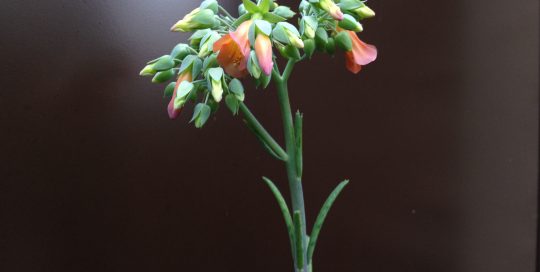Cannas in Containers
Views: 19405

Looking for a large container plant with tropical flair? If so, then Cannas might be the perfect plant for you.
Also known as Canna Lilies, these plants are very adaptable and come in a variety of sizes and colors. They prefer moist conditions. They can even be planted in water gardens! Conversely, I also have seen Cannas thrive when planted in poor soil with very little water.
Canna Lillies range from dwarf varieties that only reach 1-2 feet tall to plants that can reach 8 feet high or more.
Flowers come in yellows, oranges, reds, and pinks. For most of the summer, the lush foliage is really the star of the show. Canna leaves are large and showy. They can be solid green, dark purple, or varied in shades of yellow, green, pink, and orange. They are fantastic tall thriller elements for mixed container plantings, and they’re easy enough for gardeners of all skill levels to try.
Growing in Containers
Canna Lillies are hardy in Zones 7 and higher, so to keep them alive in my Zone 6 garden, they must be dug up in the fall and stored until the following spring. Growing them in containers makes this a much easier process.
In spring, after the last frost, discard any soft or shriveled rhizomes and plant the healthy sections in large containers. (For people in climates with short summers, Cannas may be planted indoors eight weeks before the last frost.) Cover them with several inches of potting soil and leaves should appear in a few weeks.
Cannas like sunshine, heat, and humidity, so choose a full sun location for best results, and keep them watered. They can also handle part shade, but they will not grow as vigorously as they would in full sun. Depending on the weather, it takes around 2-3 months for Cannas to mature and bloom. For example, in south-central Indiana, we’re having a cool and wet summer, so my Cannas are only 1-2 feet tall, whereas last year they were 4 feet tall and blooming by this time.
Cannas don’t require much besides water and sunshine, but occasional balanced fertilizer will improve their vigor. Throughout the growing season, trim off any tattered leaves and remove old blooms (a process called deadheading) to improve appearance. Be careful not to cut too far down the stem when deadheading to avoid cutting into future blooms growing in the stem. Just cut right below the spent bloom and you should enjoy many weeks of flowers from you Cannas.
To get a jump-start on growing Cannas, or if you don’t want to mess with digging and storing the rhizomes, they are commonly available as annuals in gallon or larger pots at nurseries and big box stores.
Saving Cannas
To save Cannas from year to year, dig up the rhizomes after the first frost and knock off any excess dirt. Cut or break them into sections with three to five eyes each (an eye is the pointed bump on each section of the rhizome) and discard any soft or shriveled pieces. I also like to trim the roots back to an inch or so long at this point. Then just stash them in a cool dark place like a basement or closet.
Rhizomes should be stored in a plastic bag with air holes and packed with peat moss or similar material to keep a little moisture around them. But I also have just tossed them in a paper bag and still ended up with plenty to plant next spring.
(Pictured: Cannas are in the third pot on the right and paired with Dragonwing Begonias and Golden Creeping Jenny.)
Meet Abbi Hayes
Abbi's Recent Posts

Kalanchoe delagoensis: Mother of Millions







